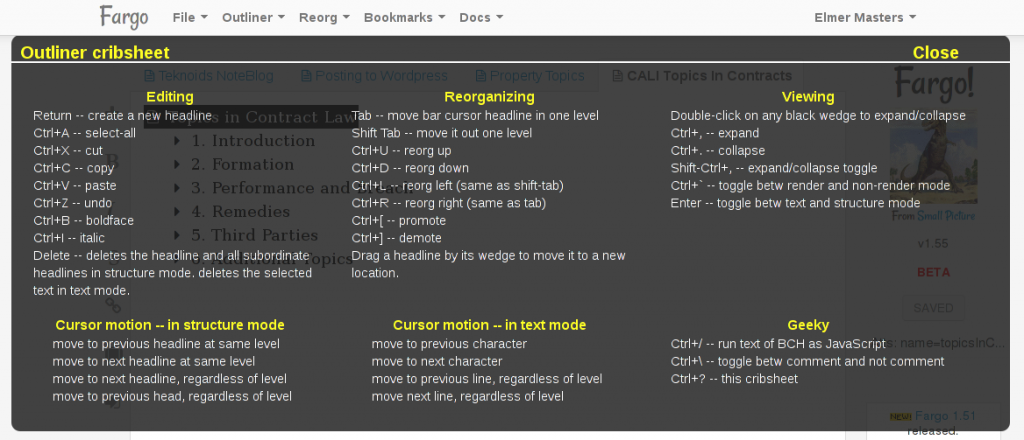Are you ready to share your OPML? :: Scripting News http://scripting.com/2016/10/12/areYouReadyToShareYourOpml.html
Manila lives! – http://scripting.com/2014/11/16/manilaLives.html “Jake Savin was doing some work with Manila, and reached a milestone, where he had it running pretty smoothly in the OPML Editor.”
Fargo Brings An Outliner to Your Browser
The following article was originally published as Dave Winer’s Outliner, Fargo on April 24, 2014 on the Slaw blog.
With his latest project Fargo, Dave Winer puts outliners where they belong, everywhere. Fargo runs in your web browser and stores your data in your Dropbox folder. This combination of browser and cloud puts the outliner everywhere making it a good choice for anyone looking for ubiquitous note taking and writing capabilities.
Why an outliner? The short answer is that you can reduce most writing to an outline, a series of expandable points or topics. If you think about it for a minute it is easy to see most legal writing as an outline. Many of those course outlines we wrote in law school as help learning the law and getting through final exams are exactly the sort of outlines that a tool like Fargo excels at. Outlining is a basic form of writing that lets the author get ideas down with an opportunity to rearrange points and expand on concepts as necessary. For me outlining most closely resembles my thought process, so an outliner is a great way for me to write.
Dave Winer knows outliners. Dave is a smart guy who creates really useful software (and much more). His history with outliners goes back over 30 years. With Fargo he brings all that experience into a cutting edge product that redefines what you can do in a browser while retaining complete control over your data. Dave has long embraced the idea that you should have the ultimate control over your data. Your data should not be locked into a closed, proprietary silo, held hostage to licensing fees and developer whims. The use of Outline Processor Markup Language (OPML) as the format that Fargo uses to store data supports this idea.
 Fargo is a full featured outliner. In a simple browser window or tab Fargo gives you a powerful outliner. You can use it to create the most simple or complex outlines with multiple levels. The editor supports copy, cut, and paste, and basic text markup like bold and italics. Content is rearranged by dragging and dropping or using keyboard shortcuts. Whole paragraphs or sections of an outline can be moved allowing you to rearrange your writing as you see fit. The outline can be expanded or collapsed as needed. Outlines can contain links out to external resources making Fargo a good choice for keeping track of links to interesting sites.
Fargo is a full featured outliner. In a simple browser window or tab Fargo gives you a powerful outliner. You can use it to create the most simple or complex outlines with multiple levels. The editor supports copy, cut, and paste, and basic text markup like bold and italics. Content is rearranged by dragging and dropping or using keyboard shortcuts. Whole paragraphs or sections of an outline can be moved allowing you to rearrange your writing as you see fit. The outline can be expanded or collapsed as needed. Outlines can contain links out to external resources making Fargo a good choice for keeping track of links to interesting sites.
Fargo is a virtual machine in your browser. Fargo runs in your web browser and saves your data to your Dropbox account. It is a full featured outliner, but it has some secrets. Fargo runs a blog editor and content management system in your browser. The CMS includes support for Markdown and a lengthy list of macros to make the content more dynamic. You can create an outline that is a presentation. It has the beginnings of a scripting language written in JavaScript with verbs you can call. You can run your own JavaScript when an outline is accessed. All running in your web browser, using Dropbox for storage and serving of pages. In short you can run a pretty nice web server with Fargo using your web browser as the engine to put your data on the Internet. Your browser and Dropbox account effectively replace a physical or virtual server and a bundle of software to put your data on the Internet.
Fun things to do with Fargo. For me the coolest thing about Fargo is all the things it lets you do with an outline. For law students and lawyers having a versatile outliner is a very good thing. Being able to share outlines and turn them into blogs or websites or presentations makes Fargo an excellent choice for an outliner. Let’s take a look at some of the things you can do with it.
- View an outline. http://elide.us/4c is the CALI Topics in Contract Law outline. This is just a static display of the outline, but it gives you some idea of how an outline could work.
- Create an outline of your own. Visit http://fargo.io to get started (note that you will need to have a Dropbox account to create outlines).
- Open your own copy of the CALI Contracts Outline. In Fargo click on the File menu and select “Import OPML…”. In the dialog that opens enter http://outlines.cali.org.s3-website-us-east-1.amazonaws.com/ContractsTopics.opml in the box and click OK. This should retrieve a copy of the contracts outline and open it on your system. You now have your very own copy to work with. You can add links and citations to relevant court opinions or class notes to it. It’s yours, feel free to experiment.
- Turn an outline into a presentation. It’s pretty easy, just follow the directions at http://fargo.io/docs/presentations.html (yes, the documentation for Fargo is written in Fargo). For an example see http://propertyoutline.smallpict.com/caliTopics.html which also serves a s a reminder to not get to wordy with your slides.
- Set up a note/link blog to track interesting things you find on the Internet. I’ve run one at http://teknoids.smallpict.com/ since late in March. It is a great way of noting things that I need/want to remember during the course of the day. There’s even an RSS feed so you can follow along, http://teknoids.smallpict.com/rss.xml. You can get started with your own blog by clicking on the last 2 links on http://teknoids.smallpict.com/2014/03/25/ and following the instructions.
- Connect Fargo to your WordPress (or Classcaster) blog and use Fargo to create blog posts that are sent to WordPress. This is one of the cooler features of Fargo. It allows you to send stuff from your outline to your WordPress blog which can be pretty handy. The first draft of this article was written in Fargo and sent along to my WordPress blog. Learn how to connect Fargo to WordPress at http://docs.fargo.io/fargo/usingFargoWithWordpress/.
Are you ready to start outlining? I hope so. Outlining is a great way to organize your thoughts and information and get things written down. Fargo is an excellent tool for outlining that requires nothing beyond a web browser and a Dropbox account to get started. Once you get started Fargo provides with a host of options for making your outlines useful. Give it a try at http://fargo.io and share you thoughts and outlines below.
BYAR! Building Yet Another Reader!
With the looming demise of Google Reader (unless, of course, they change their minds) I’ve been casting about for a reader. For a number of years I ran my own aggregators, including UserLand Radio, Feed-on-Feeds, and currently Dave Winer’s River2 in the OPML Editor. Each had (or has) its own pros and cons that I’m not going to get into. I had moved to Google Reader because it had features I liked and it was available everywhere at any time. I don’t think it was perfect and there were things about it I found annoying (again not getting into that) but on the whole it was more useful than not.
What the choices for replacing Reader? Well, there are several, the best probably paid services that provide you with a host of features now tailored to remind you of Google Reader, good or bad. Interestingly the self hosted or desktop choices have not evolved much in the past 5 years, This is most likely due to to the ‘Google effect’. Once Google moves into a space the general sense is that that is it, Google wins and innovation tends to cease or at best slow to a crawl. So it seems to have been with news aggregators.
With Google now moving out of the space there is some sense of opportunity in the reader/aggregator space. The void left by Google Reader’s exit will no doubt spur some innovation as developers begin to look at RSS news feeds as a field worth exploring. I know I’m thinking about it.
What I’m thinking of is a system I can run from one of my Linux servers, that I can access from any device in a reasonable format and share the reader with friends. On the backend PHP using cURL and SimpleXML to access an OPML store of feeds, retrieve, parse, and archive items and display in a responsive frontend built on JavaScript and Bootstrap. Display options include a river of news format or various sorts. Items are marked to archive permanently or held for a certain number of days. Publishing features allow for the sharing of items via social nets like Twitter, Facebook, and LinkedIn. Multiple personas allow for profiles setups that will let users create collections that can be handled separately. User management is handled internally or thorough various social net APIs.
Of course it all gets open sourced. Hey, watch for it on GIthub. The goal here is to create something that lets me read the info I’ve decided I want to see, and share it as I will. I guess we’ll see what happens.
Scripting News: Code nodetypes in World Outline
http://scripting.com/stories/2012/01/23/codeNodetypesInWorldOutlin.html
As you might imagine, outlines play a big role in the World Outline. And when you can make an outline behave and look like an outline, well that’s strictly good. In December I finally invested in making outline objects work just like outlines. That meant rolling up my sleeves and making no apologies for my Javascript coding. And it came out nice. Then I rested on that front for a while, let it burn in and dug some new holes over the holidays. Now on my todo list is to roll up the outline rendering tool so it’s used to render other forms of outlines. And in my world, scripts are outlines. So what the hell, let’s make it so that script code renders as an outline. There are good reasons to do this. For one it makes the code more readable. And I have lots of code. And I want to send pointers to code to Frontier newbies who are coming up now (yay!) and I didn’t want to send them pointers to flat text. That would seem to miss the point. Yes? Yes!


